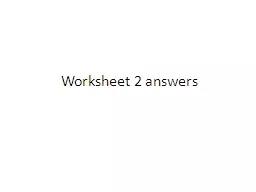

a calcium oxide CaO b potassium bromide KBr c zinc fluoride ZnF 2 d gold III iodide AuI 3 e aluminum chloride AlCl 3 f iron II sulfide FeS g silver nitride Ag ID: 661868
Download Presentation The PPT/PDF document "Worksheet 2 answers 1. Write the formula..." is the property of its rightful owner. Permission is granted to download and print the materials on this web site for personal, non-commercial use only, and to display it on your personal computer provided you do not modify the materials and that you retain all copyright notices contained in the materials. By downloading content from our website, you accept the terms of this agreement.
Slide1
Worksheet 2 answersSlide2
1. Write the formula for the following binary ionic compounds given the name:
a. calcium oxide
CaO
b. potassium bromide
KBr
c. zinc fluoride ZnF
2
d. gold (III) iodide AuI
3
e. aluminum chloride AlCl
3
f. iron (II) sulfide
FeS
g. silver nitride Ag
3
N
h. chromium (III)
phosphide
CrP
i
.
hydrosulfuric
acid H
2
S
j. tin (IV) oxide SnO
2Slide3
2. Write the formula for the following compounds with polyatomic ions given the name:
a. copper (II) nitrate Cu(NO
3
)
2
b. barium carbonate BaCO
3
c. zinc
dihydrogen
phosphate
Zn(H
2
PO
4
)
2
d. gold (III) hydroxide Au(OH)
3
e. aluminum permanganate Al(MnO
4
)
3
f. mercury (II) chromate HgCrO
4
g. ammonium phosphate (NH
4
)
3
PO
4
h. lead (IV) sulfate
Pb
(SO
4
)
2
i
. chromium (II) acetate Cr(C
2
H
3
O
2
)
2
j. phosphorous acid H
3
PO
3Slide4
3.
Write the formula for the following binary molecular compounds:
a.
disilicon
hexafluoride Si
2
F
6
b. sulfur
hexabromide
SBr
6
c. sulfur trioxide SO
3
d.
tetraphosphorus
decasulfide
P
4
S
10
e.
diarsenic
trioxide As
2
O
3
f. iodine
monochloride
ICl
g. oxygen
difluoride
OF
2
h. nitrogen
tetrabromide
NBr
4
disulfur
heptoxide
S
2
O
7
j. phosphorus
pentachloride
PCl
5Slide5
4.
Write the formula for the compounds given using :
a. lead (II) nitride Pb
3
N
2
b. manganese (III) arsenate MnAsO
4
c.
triboron
octachloride
B
3
Cl
8
d.
diphosphorus
tetraiodide
P
2
I
4
e.
iodic
acid HIO
3
f. copper (II) hydroxide Cu(OH)
2
g.
triarsenic
dinitride
As
3
N
2
h. tin (IV) phosphate Sn
3
(PO
4
)
4
beryllium nitrite Be(NO
2
)
2
j. oxygen dichloride OCl
2
k. lead (IV) carbonate
Pb
(CO
3
)
2
tetrasulfur
hexahydride
S
4
H
6
m. iron (III) acetate Fe(C
2
H
3
O
2
)
3
n. strontium hydrogen phosphate SrHPO
4Slide6
5.
Name the following binary molecular compounds:
a. P
4
O
6
tetraphosphorus
hexoxide
b
. AsCl
3
arsenic
trichloride
c. SiF
8
silicon
octafluoride
d. Cl
2
O
dichlorine
monoxide
e. S
4
N
2
tetrasulfur
dinitride
f. B
5
I
7
pentaboron
heptaiodideSlide7
6.
Name the following ionic (fixed charge) compounds:
a. Al
2
S
3
aluminum sulfide
b.
NaBr
sodium bromide
c. Mg(H
2
PO
4
)
2
magnesium
dihydrogen
phosphate
d. Al
2
(CO
3
)
3
aluminum carbonate
e. K
2
SO
4
potassium sulfate
f. BaCrO
4
barium
chromate
g. Ca(C
2
H
3
O
2
)
2
calcium
acetate
h
. HNO
2
nitrous acidSlide8
7.
Name the following ionic (variable charge) compounds:
a. Cr(NO
3
)
3
chromium (III) nitrate
b. Fe
2
S
3
iron (III) sulfide
c.
AuOH
gold (I) hydroxide
d.
Sn
(CrO
4
)
2
tin (IV) chromate
e. Mn
2
(SiO
3
)
3
manganese (III) silicate
f.
Pb
(SO
4
)
2
lead (IV) sulfate
g. Cu
2
HPO
4
copper (I) hydrogen phosphate
h. Co(CN)
3
colbalt
(III) cyanide
i
. Hg(H
2
PO
4
)
2
mercury (II)
dihydrogen
phosphate
j. Au(NO
2
)
3
gold (III) nitriteSlide9
8.
Name the following ionic or molecular compounds. Use the Nomenclature Rules
a. (NH
4
)
2
SO
4
ammonium sulfate
b.
HF
hydrofluoric acid
c.
PbO
lead (II) oxide
d. K
3
N potassium nitride
e. Se
2
Cl
4
diselenium
tetrachloride
f. AsF
5
arsenic
pentafluoride
g. AlI
3
aluminum iodide
h. N
2
O
5
dinitrogen
pentoxide
i
. Fe
3
(PO
4
)
2
iron (II) phosphate
j. Ag
2
S silver sulfide Slide10
k.
CuCN
copper (I) cyanide
l. S
3
O
6
trisulfur
hexoxide
m. Al(OH)
3
aluminum hydroxide
n. Co(MnO
4
)
2
cobalt (II) permanganate
o. HgSO
3
mercury (II) sulfite
p.
HClO
4
perchloric
acid
q. Ca(HCO
3
)
2
calcium hydrogen carbonate
r. Au
2
(CrO
4
)
3
gold (III) chromate
s
.
Mn
(H
2
PO
4
)
3
manganese(III)
dihydrogen
phosphate
t. Zn(MnO
4
)
2
zinc permanganate